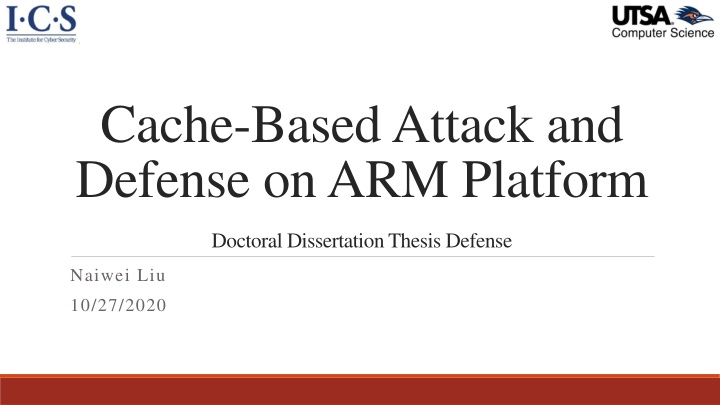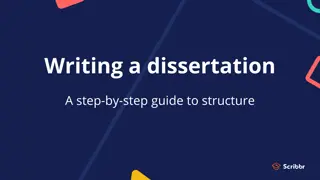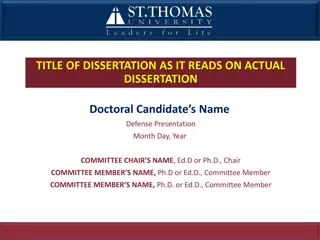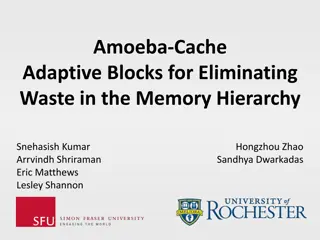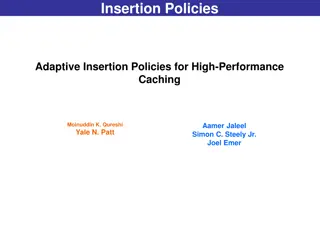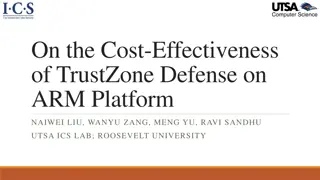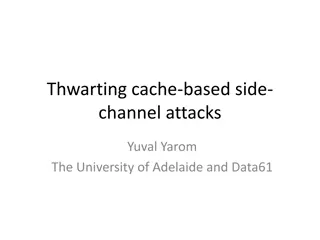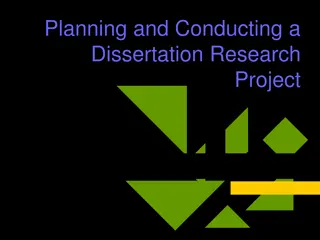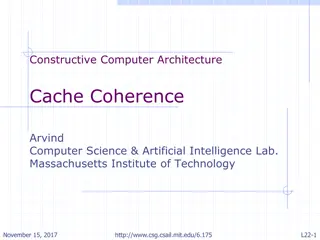Cache-Based Attack and Defense on ARM Platform - Doctoral Dissertation Thesis Defense
Recent research efforts have focused on securing ARM platforms due to their prevalence in the market. The study delves into cache-based security threats and defenses on ARM architecture, emphasizing the risks posed by side-channel attacks on the Last-Level Cache. It discusses the effectiveness of side-channel attacks, highlights vulnerabilities in TrustZone technology, and proposes a defense framework against such attacks.
Download Presentation

Please find below an Image/Link to download the presentation.
The content on the website is provided AS IS for your information and personal use only. It may not be sold, licensed, or shared on other websites without obtaining consent from the author.If you encounter any issues during the download, it is possible that the publisher has removed the file from their server.
You are allowed to download the files provided on this website for personal or commercial use, subject to the condition that they are used lawfully. All files are the property of their respective owners.
The content on the website is provided AS IS for your information and personal use only. It may not be sold, licensed, or shared on other websites without obtaining consent from the author.
E N D
Presentation Transcript
Cache-Based Attack and Defense on ARM Platform Doctoral Dissertation Thesis Defense Naiwei Liu 10/27/2020
Contents Introduction Related Work Cache-Based Security Threats and Attack Defense Design and Implementations Based on ARM Platform Future Work and Plan Conclusion 2
Introduction Abstract In Recent years, many research efforts had been made on secure and safe environment on ARM platform. ARM structure and chips based on ARM had been taking up a lot of number of products in the market. Security problems and potential risks had been discussed. Cache and similar design brings in trouble for security purposes. Uniqueness on ARM-based products made things even tougher to solve. What will we do? Design defense framework Evaluate by experiments Optimization 3
Abstract and Introduction Introduction Last-Level Cache (LLC) is always the target of side-channel attack. On x86 structure, it is always L3 cache that is attacked. Last-level cache side-channels are effective enough to extract user s private information. Side-channel: collecting information like performance counters, timing, power consumption, etc. And process the information to derive information about the victim. Most frequently used: access time-based side-channels. 4
Introduction Introduction (Continued) Side-channel attack based via LLC can be dangerous, even without compromising OS. Both on single OS machine and Virtual Machines (VMs) can be attacked. Most common: FLUSH+RELOAD LLC is shared among processes and threads. FLUSH+RELOAD can be practical using unprivileged instructions. AES key of OpenSSL is recovered by this attack in lab test. Threats to different devices Modern TrustZone Design on ARM platform 5
Introduction Introduction (Continued) Contributions Research on side-channel and covert-channel attack: bandwidth and effect. Investigation on Flush operations on ARM platform and overhead. Study of TrustZone technology and previous security design based on TrustZone. Investigation on critical instructions related to TrustZone operations. Design and test of adaptive control on flush operations. Different discussion based on ARMv8-A and ARMv8-M structures. 6
Related Work Side Channel Attacks LLC based side-channel attacks: Flush+Reload, Prime+Probe Effectiveness of LLC based side-channels 7
Related Work Security Design and Protections Hardware Solution: Intel SGX, ARM TrustZone Hardware isolation for an enclave New instructions to establish, protect Call gate to enter Remote attestation Processor manufacturer is the root of the trust Prime+Probe Attack: March 2017 Target to DRAM 8
Related Work ARM TrustZone Based on ARM Cortex-A and Cortex-M series Privileged instructions to call entry/exit Light-weighted comparing with other protection ARM helps in creating Trusted Execution Environments (TEE) Cache Problems ARM Cortex-A series ARM Cortex-M series (ARMv8-M) 9
Related Work Previous Defense Strategy against Side-Channels LLC-level Protection (memory access control) Cache enclaves (Trusted vs. Untrusted) Scheduler-based solutions Others Cache Flush against Side-Channels Benefits: easy to implement, ensure safety Problems: high overhead, not adaptive to every situation 10
Related Work Recent Research on ARM and TrustZone TrustZone-based defense; Performance measurement without security concerns; Keystone Defense Framework; 11
Overview and Background Overview This Dissertation is a re-organization of some published work during years 2018-2020, in which most experimental work had been in 2016-2018. To summary, we have two major research projects: We measure the cost and effectiveness of ARM TrustZone entry/exit and the cost of cache operations, such as Flush operations; (Published on July 2020, WISA conference) Based on the measurements and experimental results, we design and implement adaptive defense framework. We also test the defense and have both experimental and theoretical analysis; (Published on March 2018, EAI journal of security and privacy) We also have other experimental results and discussions to help and support our analysis. (Book Chapter in 2020, Eliva Press) 12
Overview and Background Cache Threats: Time-Based Attack Flush+Reload Attack 13
Overview and Background Prime+Probe Attack 14
Overview and Background Threat Model and System Assumptions Side-channel attackers and other cache-based attackers are not based on compromised OS. We assume that the memory is not shared between victim process and the attacker (Covert Channel) On system side, we assume that the operating system components in TrustZone is not compromised. we also assume the system is having a control part, i.e. handler to inject interference into possible side-channel. We also assume that the attacker has sufficient privilege to access the memory access time. This is not the case in real life, but it shows the worst case for the users to be attacked. 15
Overview and Background Step 1:An attacker utilizes the cache to launch side-channel attack, i.e. Flush+Reload attack; Step 2: the noise injector sends cache FLUSH request, and connect with system components; Step 3: Cache FLUSH instructions; Step 4: Monitors collecting performance and other data; Step 5: Cache FLUSH makes impact on victim s listening. 16
Cache-Based Security Threats and Attack Overview Users memory access are not protected by TrustZone Covert Channel (Sharing resources) TrustZone Entry/Exit without Flushing cache Side-Channel (Malicious collecting access time) Flush+Reload Attack Prime+Probe Attack Malicious eavesdropping 17
Cache-Based Security Threats and Attack Side-Channel Attack Experiment Flush+Reload Attack step 0: attacker maps shared library shared memory, shared in cache step 1: attacker flushes the shared line step 2: victim loads data while performing encryption step 3: attacker reloads data fast access if the victim loaded the line Prime+Probe Attack step 0: attacker fills the cache (prime) step 1: victim evicts cache lines while performing encryption step 2: attacker probes data to determine if the set was accessed 18
Design and Implementations TrustZone-Related Instructions ARMv8-A Test Environment: ARM Juno r1 Board, with A57 and A53 chips; QEMU as testing benchmark. ARMv8-M Test Environment: ARM Development Kits with Cortex-M4 19
Design and Implementations Experiments on TrustZone Instructions ARMv8-M Our experiments on ARMv8-M are using ARM Versatile V2M-MPS2 Motherboard with an ARM Cortex- M4 chip. It offers 8Mb of single cycle SRAM, and 16Mb of PSRAM. It supports the application of different ARM Cortex-M classes, from Cortex-M0, to M3, M4, and M7. 20
Experimental Results Experiments on TrustZone Instructions ARMv8-A We use Ubuntu 16.10 as the normal world OS, with 26 processes running on background, including the workload we use for testing. We count the smc-related instructions that belongs to TrustZone- related operations, and analyze the attributions of them. Type Non-secure to Secure Test R/W Secure to Non-secure Test R/W Others (Access from Background) Percentage 2.87% 2.91% 0.01% 21
Experimental Results Experiments on TrustZone Instructions Cortex-A Using QEMU as shown above. Operation Direction Cost on Average (Clock Cycles) P0_nonsecur e_check_regi ster_access P0_secure_c heck_registe r_access Non-Secure to Secure 1950 Secure to Non- Secure 2200 22
Experimental Results Experimental results on Cortex-M series chips 23
Experimental Results Experiments on TrustZone Instructions ARMv8-A With every smc-related instruction, we operate Flush on cache. 24
Experimental Results Experiments on TrustZone Instructions ARMv8-A We change the overall percentage of smc instructions and see the overhead difference. 25
Evaluation On the cost-effectiveness balance of defending by Flush operations Flush operations are necessary, but they cost much; We can never wipe out the risk, but can cut down bandwidth; Adaptive strategy is used to keep the balance of performance and effectiveness; On Cortex-A series chips, usually adaptive strategy can cost less than 10% overhead; Even better on ARMv8-M chips. 26
Evaluation On TrustZone related instructions Most of the apps and users are not making use of TrustZone features; On IoT devices, TrustZone is not costing much resources; It is possible to move some of the hardware/software security design into TrustZone surface; Cortex-M series chips perform better than Cortex-A series chips. On Cortex-A series chips or x86 chips, cache flush operations are just some instructions with privileges. However, the case are different on ARMv8-M. The allocation of a memory address to a cache address is defined by the designers of the applications. Because of the special structure of ARMv8-M, the cache Flush operations are sets of DSB (Data Synchronization Barrier) operations, with address-related instructions. 27
Defense Design and Implementations Based on ARM Platform Defense Strategy Hardware Defense Privilege level designs Not everybody can flush the cache or do cache related measurement, e.g., ARM When the cache should be flushed? Whenever there is a possibility of information leak - what about the performance? During process context switching? During processor mode switching? Experiments Performance and Bandwidth 28
Defense Design and Implementations Based on ARM Platform Defense Strategy Software Solution Design on ARMv8 TrustZone entry/exit Noise injections to the channels Also decrease the performance but under control. Experiments Noise Injection and Bandwidth 29
Defense Design and Implementations Based on ARM Platform Defense on ARMv8-M Challenges and limitations TrustZone for IoT Efficiency in entry/exit Defense based on TrustZone Experiment Cost of TrustZone operations 30
Design and Implementations Adaptive Flush Operations on ARMv8-A On ARMv8-A tests, we change cache flush frequency when the system is on high frequency of TZ operations. Must maintain good performance (low overhead) while keeping lower bandwidth 31
Design and Implementations Monitors Setup Time measurement: special registers and instructions; Overhead: TEE and benchmark; Cache miss rate: Special Registers. 32
Design and Implementations Other Implementations Error Correction; Flush Operation; TrustZone entry/exit. 33
Experimental Results Experiments on Side-channel Flush+Reload Attack on libjpg; Using CRC to try recovering the original file; Calculating Bandwidth and performance overhead difference by Flushing cache. 34
Experimental Results Test: Cache miss rate and overhead balance. 35
Experimental Results Test: Cache miss rate and Flush frequency balance. 36
Evaluation Dealing with covert channel is also a problem of balancing overhead and effectiveness. From our test results, it is almost impossible for some malicious users to launch covert channels with high entropy and very low bandwidth, which means that they cannot retrieve useful information, or the time consuming is not acceptable. 37
Evaluation In the experiments where we randomly insert flush operations to interfere with the side-channels, the time of injecting noise is randomly distributed. Also, the interval of each pair of operations is randomly distributed. Exponential distribution is usually used to describe the distribution of intervals of a set of statistically independent events. 38
Conclusions Cache-based attack are new focal point on security design, with risks of leaking information through side-channel and covert channels. Flushing cache is effective to cut down the risk, but with high performance overhead, and sometimes not affordable. On IoT devices, the performance of connecting with TrustZone can be better, which brings the possibility to making use of TrustZone. Adaptive strategy is still needed for the balance of the performance and the defense effectiveness. 39
Future Work and Plan Implementations and Experiments Design and implement a defense framework based on ARMv8-M. Test the performance of defense framework using some benchmarks, and optimize the framework to good effectiveness and lower overhead. Port defense framework to new ARMv8-M boards: M23 and M33 series chips. 40
Future Work and Plan Theory Work Study adaptive control method in theory to match the experimental results and predict the optimal solution of best adaptive control in defense. Investigate entropy theory based on experimental results, predictions and related theory. Discuss performance of implemented defense framework in theory and try to have theoretical conclusion on defense against cache-based attack. 41
Publications Liu N, Zang W, Chen S, Yu M, Sandhu R: Adaptive Noise Injection against Side-Channel Attacks on ARM Platform, EAI Endorsed Transactions on Security and Safety, 2019; Liu N, Zang W, Yu M, Sandhu R: On the Cost-Effectiveness of TrustZone Defense on ARM Platform, The 21st World Conference on Information and Security Applications (WISA), 2020, Maison Glad, Jeju, Korea Liu N, Yu M, Sandhu R: Cache Security on ARM: Side-channel Attack and Defense: Introduction to Side-channel on ARM Platform, Book Chapter by Eliva Press, ISBN: 978- 1952751264, 2020; Liu N, Zang W, Yu M, Sandhu R: Cost and Performance of TrustZone Defense against Cache Threats on ARM Platform, Journal of Wireless Mobile Networks, Ubiquitous Computing, and Dependable Applications (JoWUA, Invited), 2020. 43
Q&A Time Thank you so much for your questions! 44
